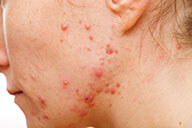Acne is one of the most common skin conditions in the United States, affecting about 50 million Americans annually. Breakouts appear in the form of pimples, whiteheads, blackheads, or painful nodules and cysts mostly on the face, forehead, chest, shoulders and upper back. If left untreated, the condition can lead to severe complications like scars (pitted skin), dark spots on the skin and other skin changes (such as hyperpigmentation or hypopigmentation).
Treatment for acne involves a combination of medications and other therapies. However, the choice of treatment modalities depends on the type of acne and its severity. Acne documentation is important for dermatologists both from the viewpoint of patient care and physician reimbursement. Dermatology medical billing and coding can be challenging. Dermatologists treating different skin conditions need to use the right ICD-10 codes to report the correct diagnoses. Relying on the services of a reputable medical billing and coding company can help in accurate and timely claim submission and appropriate reimbursement.
What Causes Acne – Types and Symptoms
Even though acne affects people of all age groups, it is most commonly seen among teenagers. It is estimated that about 80 percent of people aged 11-30 years will have at least a mild form of acne. When the condition appears during the teenage years, it is more common in males. It can continue into adulthood and when it does, it is more common in women.
Several factors can cause acne. Excess or high production of oil (sebum) in the pore is one of the main factors. Other related causes include buildup of dead skin cells in the pore, growth of bacteria in the pore, inflammation, hormonal factor or changes, use of greasy cosmetics, usage of certain medications (that contain androgen and lithium), consumption of certain foods ( including carbohydrate-rich foods) and emotional stress. Acne causes several types of lesions or pimples, which vary in size, color and level of pain.
Depending on the type and severity of the condition, the symptoms vary and these include – whiteheads (closed plugged pores), small red, tender bumps (papules), pimples (pustules), painful, pus-filled lumps under the skin (cystic lesions), large, solid, painful lumps under the skin (nodules), and blackheads (open plugged pores).
Diagnosis and Treatment of Acne – Know the ICD-10 Codes
Treatment modality for this condition may depend on the age of the patient and the type and severity of acne. Mild acne can be treated with over-the-counter (OTC) medications like gels, soaps, pads, creams, and lotions that are applied to the skin. On the other hand, moderate acne may be treated with – oral antibiotics or contraceptives, topical antimicrobials, corticosteroid injections and hormone therapy (primary used in women). For people with severe acne that does not respond to topical or oral medications, additional treatment like laser and light therapy, superficial chemical peels, and surgical procedures may be recommended to help treat and repair scarring.
Medical coding for inflammatory skin conditions like acne can be complex. Healthcare providers need to be familiar with the highly specific ICD-10 codes to report different types of acne. By outsourcing these tasks to a reputable dermatology medical coding company with AAPC-certified coding specialists, healthcare practices can ensure correct and timely medical billing and claims submission.
ICD-10 diagnosis codes for acne include –
- L70 Acne
- L70.0 Acne vulgaris
- L70.1 Acne conglobata
- L70.2 Acne varioliformis
- L70.3 Acne tropical
- L70.4 Infantile acne
- L70.5 Acné excoriée
- L70.8 Other acne
- L70.9 Acne, unspecified
Apart from the above treatment modalities, incorporating certain lifestyle modifications or habits like – washing one’s face with warm water and mild soap, avoiding oil-based makeup products, removing make-up before sleeping and wearing loose clothing (if acne is back on the shoulders or chest) — can help manage or reduce the severity of the condition in the long run. When it comes to reporting diagnoses of inflammatory skin conditions like acne, dermatologists and other physicians can rely on the services of an experienced medical billing company.




